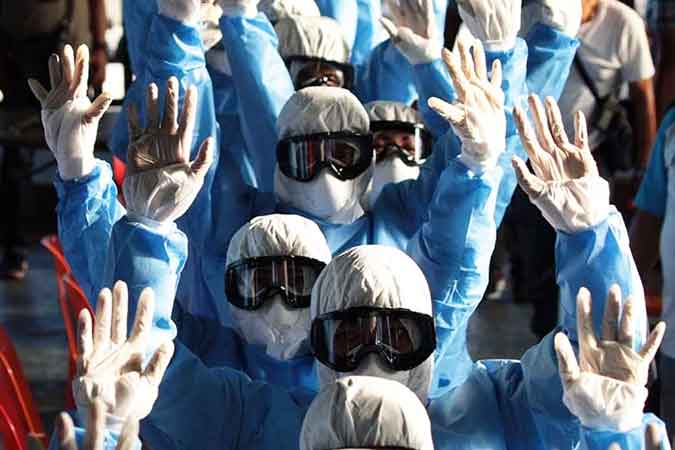One of the well-attended webinar topics in the Ako Para Sa Bata online conference was “How to handle grief.”
The panel had distinguished psychiatrist and UP Professor Emeritus Dr. Cornelio G. Banaag on Grief recovery and Mental First Aid, and Grief and transitions coach-author Catherine Sanchez-Babao. The moderator was pediatrician Dr. Michellaine Taup Tolentino.
Dr. Banaag opened the discussion on grief that will give us “a better understanding of what it is like to have lost someone in the COVID. How we can understand children who have gone through this sad arena of grief. Grief unspoken can leave a very long lasting impact in our lives.” He introduced Ms. Babao, a popular columnist and a lecturer at Ateneo University on the dynamics of grief in the Filipino context.
Grief is defined as “a response to loss that affects our physical, emotional, behavioral, social, financial and spiritual lives… a constellation of feelings and emotions.” It occurs when there is a death or any important loss. Among them: the loss of routine and freedom, employment, income, the ability to freely visit loved ones and friends, the chance to be present when people are dying or grieving.
Grief literacy is the capacity to access, process and use knowledge regarding the experience of loss.
Mourning is the expression “grief gone public.” It is a process required for healing.
We have had what are called “bad deaths” during the pandemic. The bereaved family members have difficulty grieving. They have heightened psychological symptoms because of the inability to say “goodbye” and to be together in the traditional rituals that provide support and solace. We have to be creative and use virtual platforms.
The World Health Organization identified the stressors: “Social isolation, financial problems, health concerns, worries about other family members, death of other friends and family, and anxiety about one’s own mortality.”
The pain of loss is magnified during this time. The accumulation of losses overwhelms the bereaved.
We should increase grief literacy. One should be aware of one’s own experience and understand it. There are many forms of grief and it is unique for each individual. There are no stages in grief.
“It is ok not to be ok.”
The skills needed are:
Compassionate listening. Asking questions in a sensitive manner. Helping the grieving individual find resources.
Connection. We should reach out through letters and cards or send packages when possible. Most people connect via text, phone calls, video chat or social media. Grief cannot be fixed. We can offer our attention and time to reduce the feeling of isolation.
Children need special attention and help. One should listen well. Ask them what they know and feel. Do not assume what they know based on their age. The experts say, “A child old enough to love is old enough to grieve.”
In explaining death, “the goal is to provide an age-appropriate understanding of what happened so that the child can begin to come to terms with the finality and consequences of the death.” One should provide the essential facts about the death and circumstances. Allow the child to ask questions (omit the graphic details). Keep the family routines intact as much as possible. One can plan opportunities for positive experiences, as a family. Meeting friends is not possible during this time.
Let children know that showing their feelings is ok. Show them how you cope. It is good for them to cry and talk with friends. Seek spiritual comfort and remember good things about the person who died. Have conversations with your children. Most important is to have an emotional and physical presence. Hug and talk. Show support to children and teens and adults so that they can cope with their loss.
Children express their feelings by using play and creative activities, drawing, writing. These artworks provide clues. Let them explain their art. Anger is a normal and natural response. Children can have physical activities such as sports or dancing. But they should not express anger by hitting or hurting others.
Hope and resilience are essential to survival in coping with COVID-19 related loss. “We can help families reorient hope…”
There is overwhelming despair. We need energy to rebuild lives; we need to cope in the midst of uncertainty. Studies show that resilience is developed by “focusing to master the possible, accepting that which is beyond control, and coming to terms with what cannot be changed.”
“Practice the art of the possible. Do all you can, with what you have, in the time you have, in the place you are.”
In the Q&A, the lack of sleep and memories were discussed. Dr. Banaag said, “It could be part of a depression. It is the effect of the pandemic weighing heavily on us.”
Prolonged sleep-deprivation can lead to anxiety disorder and depression. There are good sleep-aids and physicians can prescribe sedatives.
Dr. Banaag said, “We have to recognize that a certain age, like very young children, the expression of grief waxes and wanes. When they are with friends, they play. But when they are alone, they feel the sadness. At night, they cry and look at the picture of the parent… We should not be deceived by the fact that they can play.
“There are snippets of memories… A lost parent is carried in the mind. They talk to the parent. This is the richness of the imagination of childhood. They carry the memory and talk to their parent,” he explained. We lose the imagination when we grow older. “The child builds and forms the image of the lost parent in her own memory.” From what others say. “Children are like sponges. We want every child to reserve and carry a good memory of the parent.”
“Most of us in the helping profession are wounded. We have to touch people with compassion.”
“Reinvest into something. Remove the emotional investment in the person who died. We need to do that. We need to reengage in the realities around us.
“Grief is a work of the heart and the mind,” Dr. Banaag stated.
A delegate asked, “When am I healed?”
“Reconcile with your loss and look forward. And reinvest. There is no chronology in grief. Hang on. Keep the hope. Kindness and compassion,” Ms. Babao said.
Dr. Banaag added, “We feel compassion and grief and we don’t talk about that… We work with abused children…
“Grief and depression are similar. One is a normal process that we all go through. There is a difference between sadness expressing grief. Depression is an illness.
“Clinical depression could run parallel to grief. Grief needs to be expressed.”
Dr. Banaag thanked the organizers, Child Protection Network (CPN), for making this discussion possible. “We should be mindful of how we are getting traumatized. I am deeply grateful to them (CPN) and to Cathy for taking this topic and walking us through this painful process …in confronting our own grief. This has given us an opportunity to have practical tips on how to help others and to help one another,” Dr. Banaag remarked.
The webinar on grief had 3,000 attendees on Zoom and FaceBook live. (According to the registration, 48% of the audience has experienced grief in the pandemic.)
Ako Para Sa Bata webinars, presented by Child Protection Network and UNICEF, will run every Tuesday and Thursday from 10 to 11:30 a.m. until Nov. 24.
Maria Victoria Rufino is an artist, writer and businesswoman. She is president and executive producer of Maverick Productions.
mavrufino@gmail.com
 Police, NBI asked to go after scammers using typhoon victims
Police, NBI asked to go after scammers using typhoon victims 

